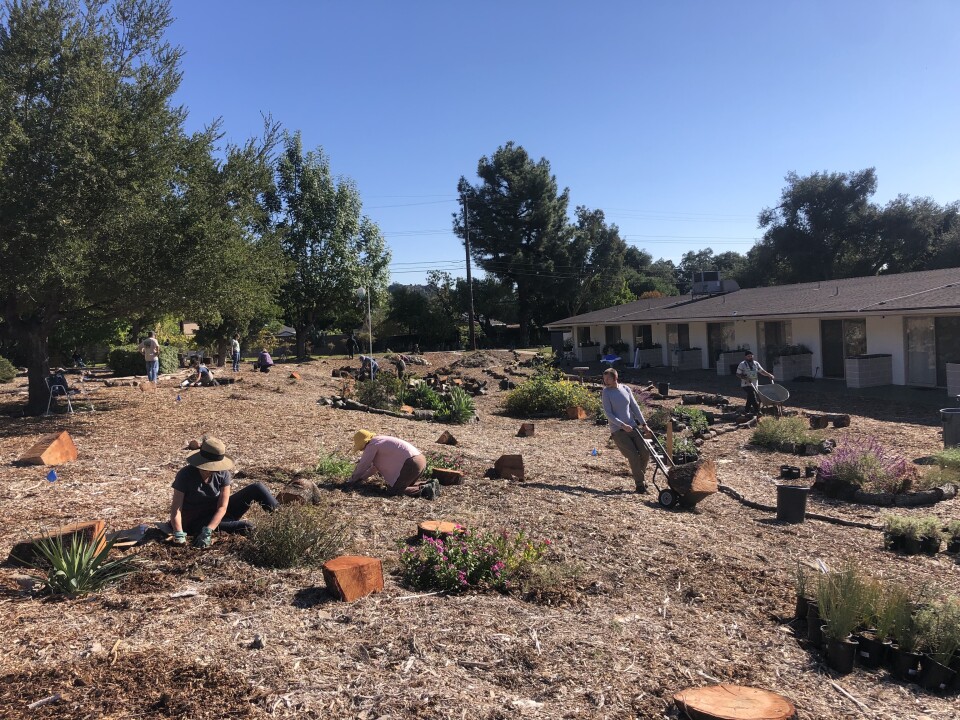Truth matters. Community matters. Your support makes both possible. LAist is one of the few places where news remains independent and free from political and corporate influence. Stand up for truth and for LAist. Make your year-end tax-deductible gift now.
A Monrovia Convent Was Battling Rising Costs. Here's How Ripping Out Its Lush Lawn Will Preserve Its Future

Susan Woodall pulls bits of stubborn grass and weeds from deep brown soil, then places a square of cardboard down and covers it with mulch.
She’s volunteering to help turn a sprawling lawn into a native plant and pollinator heaven at the Maryknoll Sisters Catholic convent in Monrovia, in the foothills of the San Gabriel Mountains.
Woodall, a Monrovia resident for 36 years, heard about the project through a city newsletter. She decided to volunteer, interested in learning how to convert her own lawn.
“With the drought and everything else, I'm trying to find ways that I can still have a beautiful yard without, you know, taxing our resources,” she said. “Native plants are so beautiful — there are just so many different colors. I never thought about them — I always thought of things like cactuses.”
“Grass is pretty,” she continued, “but so is this, it’s just a different kind of pretty. ”
Convents usually have carefully-tended landscapes with lush green lawns — after all, in the Bible, Solomon opines that an untidy yard is a sign of laziness. But keeping a lawn is both expensive and environmentally unfriendly in a dry southern California that’s only getting drier as the climate crisis accelerates.

The nuns — mostly in their 70s, 80s, and 90s — were close to having to sell the property, a former hospital that was converted into a retirement residence in the 1970s. They faced rising costs, including an ever-growing water bill to support six acres of lush landscape.
Enter non-profit Grow Monrovia and one of its founders Rosemary Gavidia. The lifelong Monrovian pitched an idea to the sisters: apply for a turf removal rebate from the city and replace the lawn with drought-tolerant plants. That way, the property could become a peaceful space for the community and local wildlife, instead of being sold off and developed. The sisters agreed.
“We are trying to bring the community together and create a biodiversity center and community learning space,” Gavidia said. “With the grass being there, it wasn't really being used and it was taking a lot of resources like fertilizer and water.”

The retired nuns declined to be interviewed for this story, but one of them, Sister Arlene Trant, described on Grow Monrovia’s website why the convent decided to participate in the project.
“They organize talks and workshops on many different aspects of environment protection. And through these workshops I truly had a conversion experience,” she wrote. "I now see more clearly…that we can continue our missionary vocation by caring for our beautiful 6+ acres of land — not only the plants and trees, but also nurturing the abundant wildlife — birds, squirrels, deer, coyotes and an occasional bear who frequent our property! I learned that the beautiful grass which I loved so much is actually bad for the environment.”
“I’m beginning to see with new eyes that the birds, butterflies, and bees are not just lovely in themselves, they are essential workers in re-creating our world,” Trant wrote on. “The worms, insects, fungi and other organisms are unseen workers who help to nourish the soil for future generations. Wow!”
Gavidia marshaled a small army of volunteers — about 40 people — to tear out 20,000 square feet of lawn. They set down cardboard to keep down weeds and grass regrowth while still allowing rain to seep into the ground and support healthy soil fungi. They laid down mulch to trap moisture in the soil and started planting batches of California native plants.

They’ve also constructed a bioswale and dry river to capture stormwater and help it seep into the landscape and prevent flooding. There’s an oak grove that will eventually have winding paths with various spots for peaceful reflection. They’ll eventually complete a system to capture morning dew that will help cut water use down even more.
Gavidia said the sisters were watering three times a week. Now they’re down to just one day for a shorter period of time.
We see all these negative reports of the temperatures going up and running out of water. It makes you feel good to be able to actually do something to change it.
So instead of tidy green grass, throughout the year California native plants such as pitcher sage will bloom into purple flowers, attracting hummingbirds. Butterflies, birds and bees will hover over pink and white desert willow blossoms.
“We see all these negative reports of the temperatures going up and running out of water,” Gavidia said. “It makes you feel good to be able to actually do something to change it.”








